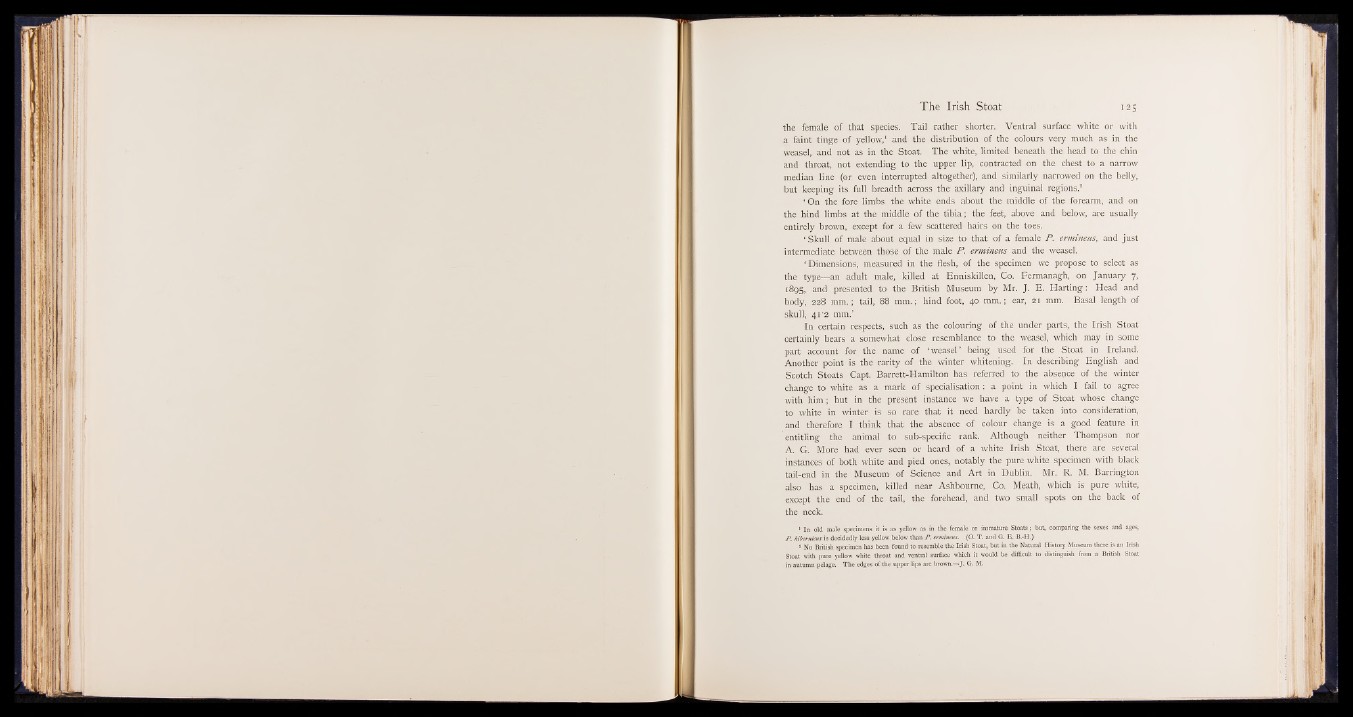
the female of that species. Tail rather shorter. Ventral surface white or with
a faint tinge of yellow,1 and the distribution of the colours very much as in the
weasel, and not as in the Stoat. The white, limited beneath the head to the chin
and throat, not extending to the upper lip, contracted on the chest to a narrow
median line (or even interrupted altogether), and similarly narrowed on the belly,
but keeping its full breadth across the axillary and inguinal regions.2
‘ On the fore limbs the white ends about the middle of the forearm, and on
the hind limbs at the middle of the tibia; the feet, above and below, are usually
entirely brown, except for a few scattered hairs on the toes.
‘ Skull of male about equal in size to that of a female P . ermineus, and just
intermediate between those of the male P . ermineus and the weasel.
‘ Dimensions, measured in the flesh, of the specimen we propose to select as
the type—an adult male, killed at Enniskillen, Co. Fermanagh, on January 7,
1895, and presented to the British Museum by Mr. J . E . Harting: Head and
body, 228 mm.; tail, 88 mm.; hind foot, 40 mm.; ear, 2 1 mm. Basal length of
skull, 41'2 mm.’
In certain respects, such as the colouring of the under parts, the Irish Stoat
certainly bears a somewhat close resemblance to the weasel, which may in some
part account for the name of ‘ weasel’ being used for the Stoat in Ireland.
Another point is the rarity of the winter whitening. In describing English and
Scotch Stoats Capt. Barrett-Hamilton has referred to the absence of the winter
change to white as a mark of specialisation : a point in which I fail to agree
with him; but in the present instance we have a type of Stoat whose change
to white in winter is so rare that it need hardly be taken into consideration,
and therefore I think that the absence of colour change is a good feature in
entitling the animal to sub-specific rank. Although neither Thompson nor
A. G. More had ever seen or heard of a white Irish Stoat, there are several
instances of both white and pied ones, notably the pure white specimen with black
tail-end in the Museum of Science and Art in Dublin. Mr. R. M. Barrington
also has a specimen, killed near Ashbourne, Co. Meath, which is pure white,
except the end of the tail, the forehead, and two small spots on the back of
the neck.
1 In old male specimens it is as yellow as in the female or immature Stoats; but, comparing the sexes and ages,
P . hibernicus is decidedly less yellow below than P . ermineus. (O. T. and G. E. B.-H.)
2 No British specimen has been found to resemble the Irish Stoat, but in the Natural History Museum there is an Irish
Stoat with pure yellow white throat and ventral surface which it would be difficult to distinguish from a British Stoat
in autumn pelage. The edges of the upper lips are brown.—J. G. M.